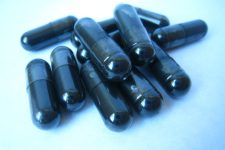
Before really learning about the different herbal remedies, I remember hearing “compress” and “poultices” and then thinking they were one in the same.
Well, over the years, I have come to understand that compresses and poultices are similar, but not the same.
Compresses and poultices are excellent remedies to be used in acute (sudden onset) illness situations because they often provide quick relief from symptoms.
How to Make a Compress
A compress uses a soft cotton cloth dipped into either a hot or cold herbal infusion – this is based on the treatment necessary for the ailment. The cloth is then applied externally to the affected area. Learn how to make an infusion by clicking here…
Compresses can be used to successfully treat chest congestion, strains and sprains, inflammations of all kinds, and sunburns.
To make a compress, we must:
- Prepare a very strong herbal infusion or decoction (depending on the herbs used).
- Dip the cloth into the liquid and saturate it completely.
- Apply compress directly on the affected area and keep it on for 30-45 minutes.
- Dip the cloth back into the mixture and repeat several times a day, as needed.
A few herbs commonly infused and used as a compress include:
Arnica. As a compress, arnica acts as an anti-inflammatory and excellent reducer of pain. It is a wonderful herb to have on hand for minor bumps, bruises, aches and pains. However, it’s important to note that it should never be used on broken skin.
Chamomile. Ahhh…chamomile. Most often used as a relaxant, chamomile is also an antihistamine that has an anti-inflammatory effect when used as a compress. It can be used externally to treat minor cuts, scrapes and abrasions — it’s also beneficial when used for managing eczema.
Peppermint. A peppermint compress is a wonderful treatment for headaches. It’s also helpful for relieving the pain that comes from muscle sprains and strains.
How to Make a Poultice
A poultice is another remedy that is used externally; however in this case, the plant material is mashed or grated and made into a paste that is directly applied to the ailment.
In first aid situations, we use poultices when treating stings, bug bites, rashes, burns, sprains, and skin eruptions.
To make a poultice you should:
- Prepare the herbs by mashing or grating and then mixing them with just enough water to make a paste.
- Apply the paste directly on the ailment.
- Cover with a clean piece of flannel cloth or sterile bandage.
A few herbs commonly used as a poultice include:
Chickweed. Used for the treatment of extreme itchiness of the skin, a poultice made from the chickweed can easily help in soothing the affected area of the skin.
Plantain. Plantain is a common weed — often found growing in the wild — that has great drawing power. A plantain poultice is perfect for use on bug bites and bee stings.
Lemon Balm. A lemon balm poultice can be used on minor wounds in order to prevent infection. It’s also great for use on cold sores, scorpion stings, and insect bites.
What type of compresses and poultices have you used?





I remember my mother would always make a mustard plaster for chest congestion. Once she gave my father a nasty burn, because it was too strong…
When we were little and got splinters, my mom would always make a bread and milk poultice to draw the splinter out. It was literally a small piece of bread crust that had been soaked in milk. It worked 🙂
I was in a bad car accident, leaving my arms, legs, and chest very heavily bruised. My sister made a Comfrey compress and covered me in cotton cloths for the first two days after. I was amazed at how quickly the swelling and pain went away. I will never be without Comfrey in my gardens!!
Yarrow poultice for wounds, it brings down infection. We use this around here a lot. It worked great on the puncture wound I got from stepping on a nail – no infection at all.
yarrow also helps to coagulate blood more quickly for fresh cuts/scrapes. it’s a great thing to know if your little ones have a spill on the trail cause you can usually find some growing near by with little problem.
Comfrey.My son broke his collar bone completely in two, with a finger space in between the bone. We used BHS comfrey and made a poultice/compress by: pouring hot water over the herb [just enough to cover the herbs], letting it steep for a bit, putting the herbs and any liquid in a gauze. We then placed the soaked gauze with herbs on the area of breakage twice a day. His Dr. said it would take 8 weeks or more. His bone was completely healed in 4 weeks! Awesome stuff!
Bentonite clay works well to draw out any infection or toxin that might be causing swelling…also I remember my mom using an old German remedy when I was little of freshly sliced onion and grated castile bar soap applied directly to the skin to draw out an infection. It really worked well! I’ve used it since I’ve become a mommy and with great success.
I absolutely LOVE this Kitchen Pharmacy series. I also LOVE, LOVE, LOVE this blog and look forward to all the emails in my inbox. Thank you so much for posting the things you do. I find them AWESOME and always tell my friends about this blog. I just wanted you to know that you rock and I appreciate all the good info!! Keep it coming!!!!
Please can you tell me what kind of poultice to use for chronic pancreatitis.
My husband has a nasty “zit” on his back more like a hard cyst, it doesnt yet have a “head” on it but is so tender and hurts to the touch ! What can I poultice to help bring to to a head and draw the poison out ???